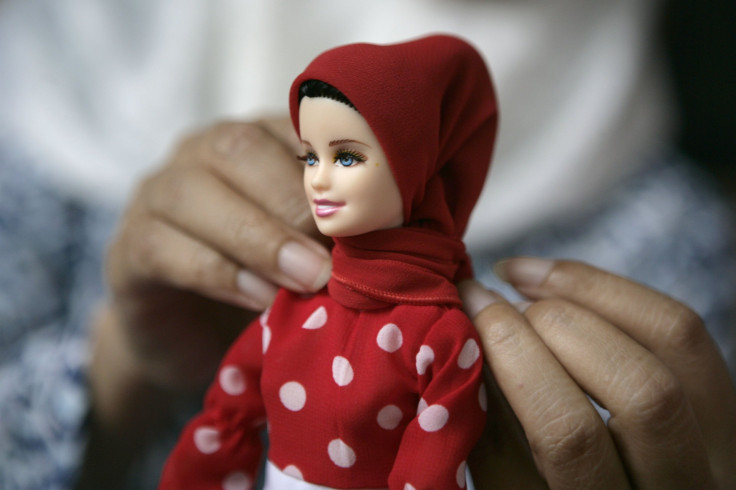First Hijabi Barbie Gets Mixed Reactions From Twitter Users

Famous Barbie doll manufacturer Mattel unveiled their first hijab-wearing Barbie, which was modeled after American fencer Ibtihaj Muhammad, who competed in the 2016 Olympics held in Rio de Janeiro, Brazil, donning the headscarf.
Apart from the cultural attire, the doll itself is designed after Muhammad, which means the Barbie is dark-skinned, instead of porcelain. Also the doll’s signature miniature waistline, which has often been criticized for being a sex-symbol, has been traded for a curvier figure. The doll comes complete with fencing gear, including a mask, a sabre and training shoes.
We are so excited to honor @IbtihajMuhammad with a one-of-a-kind #Barbie doll! Ibtihaj continues to inspire women and girls everywhere to break boundaries. #Shero #YouCanBeAnything #GlamourWOTY pic.twitter.com/oV0e6ClgL6
— Barbie (@Barbie) November 13, 2017
"When I think about my own journey, me being a Muslim girl involved in the sport of fencing, there were people who made me feel like I didn't belong," Muhammad said, the Guardian reported. "For all those people who didn't believe in me, this Barbie doll is for you."
“Today, I’m proud to know that little girls who wear a hijab and, just as powerfully, those who don’t, can play with Barbie in a headscarf,” Muhammad added. "She's a Barbie who is strong enough to wield a giant sabre and dedicated enough to spend years working her way to an Olympic medal. I know that the more diverse dolls are offered, the many more inspiring stories girls will be able to tell.”
The Barbie was unveiled by the company at the Glamour's Women of the Year summit. The hijabi Barbie was number 10 in Mattel’s long line up of “Shero Barbies.” Other Barbies in this line up were modeled after inspirational people, who dared to be unique, such as singer Zendaya Coleman, actress Emmy Rossum, singer Kristin Chenoweth and director Ava DuVernay.
So how did Mattel choose their “Sheroes”? According to the Barbie-making company, in order to qualify, a woman should have broken boundaries, be an inspiration for women and, of course, played with Barbie dolls when they were young. Just like Muhammad's, Barbie dolls inspired by Olympic gymnast Gabby Douglas, ballet dancer Misty Copeland and model Ashley Graham, went into production in 2016.
At the time, Mattel had delivered on Copeland’s request that the dolls designed after her should “really reflect a dancer’s body and also not shy away from the fact that I have muscular calves, hips, a bust, and brown skin,” the New Yorker reported.
Graham also had her specific instructions: “There’s no such thing as a thigh gap on my body. I wanted it to have cellulite, but they said it would look like a mistake.”
When news of the first hijabi Barbie hit the social media, many people were thrilled to find that their favorite childhood dolls were no longer limited to white-skinned, western clothes-wearing versions.
Mattel just announced that it will be releasing its first ever hijab-wearing barbie and OMG its perfect 💕 pic.twitter.com/N78CeUj8Bg
— Common Muslim Girl (@HijabiPosts) November 14, 2017
🗣the first hijabi wearing Barbie is a BLACK WOMEN....a BLACK WOMEN..if this doesn't cross religious and racial barriers idk what will !!
— 🍵✨ (@ShaziyaLM) November 15, 2017
Barbie finally modeled a doll after a Hijabi Muslim woman -- and it's modeled after black Olympian Ibtihaj Muhammad. This is going to mean everything to young Muslim girls. https://t.co/muCAUMepw3 pic.twitter.com/1qpjdTCIIm
— Simran Jeet Singh (@simran) November 13, 2017
You know I never even realized that there wasn't a hijabi Barbie until now because when I was a kid I would put hijabs on them myself 😂
— STARs were FREED (@starshynebrite) November 15, 2017
It was so painful as a little girl to not see hijabi role models and toys. I hope this new Barbie doll can help young girls realize that hijabs are not a burden but a token of their identity and pride.The hijab is a CROWN worn by choice and esteem. Shine queens❤️✊🏾
— Fay (@icefayfayfish) November 15, 2017
However, there were a few negative reactions to the Barbie, with people rebuking Mattel for designing dolls that teach kids about traditional outfits, which have often been perceived as a sign of oppression.
You want this here? Mattel HIJABI BARBIES Now With Islamic headbags. What’s next, Jihad Joes? https://t.co/6GtFt9obUU
— Zing ❌ (@zingars_) November 14, 2017
© Copyright IBTimes 2024. All rights reserved.












